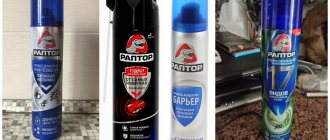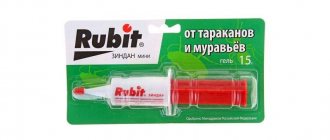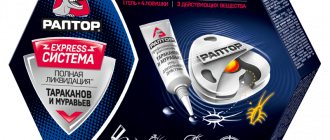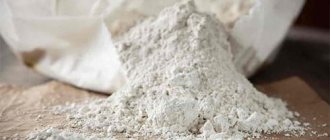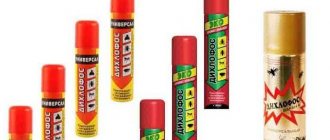In the fight against various insects, including cockroaches, Dichlorvos has been used for a long time: the drug has shown itself to be an effective fast-acting remedy.
Flies, mosquitoes, wasps, fleas and many other types of pests die under its influence within a short time.
- 4.1 How long does Dichlorvos work against cockroaches?
- 13.1 Symptoms
Types of Dichlorvos
Modern Dichlorvos is an innovative universal product for exterminating pests. The industry produces different types of the drug. Their active components are similar, but the composition is significantly different.
Kinds
This allows you to select the version of Dichlorvos that is intended to destroy a specific type of pest. Currently popular:
- Dichlorvos is universal. Due to the presence of several active components, the drug can be used to kill many types of insects. The difference between universal Dichlorvos and other products with the same name is the duration of action and the presence of a specific odor.
- station wagon. To improve the characteristics of the drug, toxic impurities were introduced into its composition. Thanks to this, Dichlorvos can destroy insects not only in apartments, but also in the open air, which makes it one of the best drugs for fighting cockroaches. It is perfect for use in large rooms. The disadvantage of the drug is a strong pungent odor that does not dissipate for a long time and is easily absorbed by some things.
- Dichlorvos "Neo". Aerosols of this brand are available in both odorless and flavored versions. The drug is distinguished by both its duration of action (about 14 days) and its versatility - it is suitable for the destruction of flying and crawling pests.
Dichlorvos brands are no less in demand - Varan, Eco, Extra and others.
Who does this toxic substance help?
After obtaining this substance, scientists claimed that it quickly dissolves in the environment without causing any harm to it. This was attributed to the merits of the product. Further study of the drug revealed that the components of the drug remain active for a long time, causing great harm to the entire environment.
Cruciferous flea beetle in the garden: 4 safe ways to control the pest
Nevertheless, dichlorvos is successfully used to destroy:
- Insects in the house (cockroaches, flies, bedbugs);
- Garden pests (whiteflies, caterpillars, spider mites, thrips and other pests);
- Parasites. When treating wheat grains with the product, their sterility is achieved; Fleas, ticks and other external parasitic insects in dogs, cattle and humans.
- Vernal insects in dogs, cats, livestock and people.
The components of the substance are able to penetrate the outer cover of insects, and also have a deadly effect when they enter the digestive system of parasites. Less effective exposure occurs when toxic fumes are inhaled.
The best results are observed when affecting crawling insects such as cockroaches and bedbugs. Spraying the substance on the surfaces along which parasites move ensures the penetration of the poisonous product through the outer shell of the pest and its neutralization.
Dichlorvos is produced in various variations:
- Aerosol;
- Concentrated;
- As an impregnation.
In our country, spray cans with a poisonous component are most often used - for home use and impregnation - in veterinary medicine. Typically, collars for dogs and cats intended to kill fleas are impregnated with the composition.
It is not so often that the component is added to special drops for application to the withers of the animal. Recently, in stores you can find special plastic strips impregnated with a poisonous composition. They are laid out indoors to repel or destroy parasites. Crawling through such barriers, cockroaches or bedbugs die within 24 hours.
Getting on the outer shell, the poison completely destroys the nervous system of the insect, which is why it immediately dies.
Control of insects in the apartment and house
The desired effect in pest control can only be ensured by proper treatment of premises. For each type of insect there are some subtleties of using Dichlorvos in an apartment, since the mechanism of action of the aerosol on them has some differences.
Cockroaches
To achieve the greatest success in exterminating cockroaches, you need to know how to properly use Dichlorvos in the fight against them. It is impossible to use an aerosol to treat food or make it into a bait that pests love to eat.
Accordingly, preference should be given to treating with Dichlorvos those surfaces where cockroaches like to be. For the poison to take effect, it is necessary to provide direct contact with the pests. To do this, you need to remove the dishes and food, and then process the following in the apartment:
- walls inside cabinets and rear outer walls;
- floors near sinks, pipes, toilets;
- baseboards in areas where cockroaches have been observed;
- cracks, ventilation grilles.
Then you need to close the room and leave it. After 2.5 hours, the room should be ventilated and wet cleaned.
conclusions
Disinfectors often encounter biological resistance of pests. In case of “irritability”, it is necessary to carry out complete disinsection of the building, and if there is a suspicion of resistance, then treat more than once, alternating drugs according to certain schemes.
Do you want to destroy cockroaches so that you immediately forget about the problem? Avoid aerosol products. Instead, use emulsion concentrates (according to the instructions). And remember that eliminating the outbreak locally is easier and cheaper than when cockroaches are everywhere and you need to carry out a complete pest control of the building.
Sources
- https://uborka-v-dome.ru/byitovaya-himiya/dihlofos-kak-polzovatsya.html
- https://chistsovet.ru/sredstva/dihlofos-sostav-svojstva-instruktsiya/
- https://vrediteli.info/dihlofos-instruktsiya-po-primeneniyu/
- https://parazitam-stop.com/nasekomye/sredstva/dihlofos-neo.html
- https://podomu.info/vermin/dihlofos-ot-tarakanov.html
- https://PosudaIzKamnya.ru/sredstva/dihlofos-protiv-klopov.html
- https://domovod.guru/borba-s-vreditelyami/sredstva-ot-vreditelej/dihlofos-vreden-li-dlya-cheloveka.html
- https://domopravitelnitsa.com/borba-s-vreditelyami/chto-takoe-dihlofos-i-dlya-borbyi-s-kakimi-nasekomyimi-on-effektiven.html
- https://geradez.ru/dihlofos-ot-tarakanov-ru
[collapse]
How does Dichlorvos act on cockroaches?
Pyrethroids are components of Dichlorvos that have a nerve-paralytic effect. After direct contact with the sprayed aerosol, the substances enter the body of insects. They penetrate the chitinous cover or the respiratory system, causing paralysis.
Baiting cockroaches
The advantage of pyrethroids is their long-lasting effects. It is enough to apply Dichlorvos in the apartment once, and it will remain on surfaces for a long time (at least 2 weeks), maintaining its properties. During this period, the aerosol will kill cockroaches, gradually reducing their population.
How long does Dichlorvos work against cockroaches?
After spraying, the drug continues to act for 15 days. If cockroaches still remain in the apartment, the treatment must be repeated.
Consequences
Dichlorvos is characterized by the fact that its exposure causes both immediate consequences (complications) and long-term consequences.
Complications appear within two weeks from the moment the substance enters the human blood. The patient begins to suffer from:
- toxic hepatitis;
- nephropathy;
- pneumonia;
- dystrophy of the heart muscle.
Long-term consequences appear within three years from the moment the substance enters the human blood. The patient begins to suffer from:
- astheno-vegetative syndrome : disturbances in the functioning of internal organs due to poor functioning of the autonomic system;
- myeloradiculitis : simultaneous inflammation of the human spinal cord and spinal roots;
- polyneuritis : diseases of the peripheral nervous system.
For pregnant women, dichlorvos poisoning is doubly dangerous. If it occurs during an early period, the fetus may freeze. If during the last months, the fetus may develop developmental abnormalities or even the death of the unborn child.
Bedbugs
Instructions for using Dichlorvos to kill bedbugs have their own characteristics. The aerosol must be used to treat those places with which they come into contact, and these are upholstered furniture, bedding, beds, books, peeling wallpaper, electrical sockets and switches.
To find bedbug nests, you need to move cabinets, dismantle beds, and take out books. Having discovered a nest, it should also be treated with an aerosol, spraying Dichlorvos and around it at a distance of about 25 cm. Repeated treatment is carried out after a week.
Fleas
Dichlorvos can only be used to remove fleas when treating pet bedding, carpets, and furniture, but it should not be applied to the pets themselves.
Flea
It is necessary to spray the aerosol on the walls to a height of up to 1 m (the height of an insect's jump). After 10-12 days, the treated items must be washed in the hottest possible water, and the walls and furniture must be thoroughly washed with detergents.
Recommendations
- ^ a b
"Dichlorvos".
Haz card
. US National Library of Medicine. August 2015. Retrieved 2015-10-13. - Das S (2013). "Review of the toxicity of dichlorvos to fish." Current World Environment Journal
.
8
(1). Doi:10.12944/CWE.8.1.08. - “Which pesticides are banned in Europe?” (PDF). pan-europe.info
. 2008. - Gillett JW, Harr JR, Lindstrom FT, Mount DA, St Clair AD, Weber LJ (1972). "Evaluating the Human Health Hazards of Dichlorvos (DDVP), Particularly in Resin Strips." Remnant Reviews
.
44
: 115–59. Doi:10.1007/978-1-4615-8491-9_6. ISBN 978-0-387-05863-4. PMID 4576326. - Pancetti F, Olmos S, Dagnino-Zubiabre A, Rosas S, Morales B (December 2007). "Noncholinesterase effects induced by organophosphorus pesticides and their relationship with cognitive processes: implications for acylpeptide hydrolase action." Journal of Toxicology and Environmental Health, Part
B.
10
(8): 623–30. CiteSeerX 10.1.1.334.9406. Doi:10.1080/10937400701436445. PMID 18049927. - Booth ED, Jones E, Elliott BM. (December 2007). "Review of the genotoxicity of dichlorvos in vitro and in vivo". Regulatory toxicology and pharmacology
.
49
(3): 316–26. doi:10.1016/j.yrtph.2007.08.011. PMID 17936460. - Espeland, M., Irestedt, M., Johansson, K. A., Akerlund, M., Berg, J. E., Kellersjö, M. (January 2010). "Exposure to dichlorvos interferes with the extraction and amplification of insect DNA in museum collections." Frontiers of Zoology
.
7
: 2. Doi:10.1186/1742-9994-7-2. PMC 2819063. PMID 20148102. - Mennear JH (June 1998). "Dichlorvos: a regulatory puzzle." Regulatory toxicology and pharmacology
.
27
(3): 265–72. Doi:10.1006/RTph.1998.1217. PMID 9693077. - "Dichlorvos (DDVP): exclusion of certain applications and directions." US Environmental Protection Agency: Office of Pesticide Programs. April 19, 1995 pp. 19580–19581. Paper control number OPP-38511.
- Vina M (September 11, 2014). “Pesticide levels in waterways have dropped, reducing risks to people.” New York Times
. - Brooks M. (May 17, 2010). "Organophosphate Pesticides Associated with ADHD." Medscape
. - Bouchard MF, Bellinger DC, Wright RO, Weiskopf MG. (June 2010). "Attention-Deficit/Hyperactivity Disorder and Urinary Organophosphate Pesticide Metabolites" (PDF). Pediatrics
.
125
(6):e1270-7. Doi:10.1542/pedy.2009-3058. PMC 3706632. PMID 20478945. - Raeburn, P. (August 14, 2006). "Slow acting." Scientific American
. Vol. 295 no. 2. paragraph 26. doi:10.1038/scientificamerican0806-26. - ^ a b
NIOSH Pocket Guide to Chemical Hazards. "#0202". National Institute of Occupational Safety and Health (NIOSH). - “The preferential effect of Dichlorvos (Vapona) on bacteria deficient in DNA polymerase” (PDF). Cancer Research
. - "A Grand Court Victory for Public Health." www.nrdc.org
. - ^ a b
"Dichlorvos".
Immediately hazardous to life and health (IDLH) concentrations
. National Institute of Occupational Safety and Health (NIOSH). - Brunner, John (1972). Sheep look up
. New York: Ballantine Books. p. 220. ISBN 978-0-06-010558-7. LCCN 72-79705.
Security measures
In Soviet times, the question of whether Dichlorvos is harmful to humans was not on the agenda. Everyone understood that it was really harmful. Nowadays, thanks to the changed formula, it is not so dangerous to health, but nevertheless it is necessary to remember that Dichlorvos is a rather aggressive drug, so it should not be allowed to get into the mouth, nose, or eyes.
The drug is also dangerous when it gets on hygiene items. Therefore, soap, personal belongings, and food must be removed before treatment with Dichlorvos.
In addition, you must wear protective equipment:
- clothes with long sleeves;
- scarf or hat;
- gloves:
- glasses.
Means of protection
People and animals are also first removed from the house. A few hours after treatment, the premises are ventilated and wet cleaning is carried out.
Description of the drug
Dichlorvos is a pesticide with a broad spectrum of action. The original chemical belongs to the class of organophosphorus compounds, which implies, among other things, a limited period of protective action (about three days).
At one time, dichlorvos became widespread due to its effective effect on such household pests and parasites as:
- flies,
- cockroaches,
- mole,
- ants,
- bedbugs,
- fleas.
Some time ago, dichlorvos was replaced by relatively safe and more advanced formulations based on pyrethroids, but for various reasons, manufacturers of modern products continue to use the familiar name.
Pyrethroids have replaced pesticides today.
Pyrethroids are divided into three classes: first, second and third generations, and the first ones are practically not used today, they were replaced by subsequent groups.
Derivatives of the first and second classes of insecticides can be found in a wide variety of products, including those intended to combat domestic insects. This is for example:
- mosquito coils,
- plates,
- aerosols.
The most modern third-generation pyrethroids do not contain ester groups and therefore have high activity along with reduced toxicity to fish, birds and bees.
Types of dichlorvos
The drug is mainly produced in the form of aerosols and sprays. There are also products packaged both in small bottles of ten milliliters and in large containers, canisters and cylinders with a volume of up to ten liters.
There are different types of dichlorvos
Table: the most common aerosols
| Drug name | a brief description of | approximate cost |
| Dichlorvos Neo | Low-allergenic, fragrance-free product with virtually no unpleasant odor | 100–300 rubles (depending on volume) |
| Dichlorvos ECO | A powerful product with a lavender scent that dissipates fairly quickly. | 90 rubles and above |
| Dichlorvos Varan | Effective insecticide with lemon scent | 90–200 rubles (depending on volume) |
| Dichlorvos Super | It has a strong unpleasant odor, but is very powerful in its effect on pests. | 100 rubles |
All listed in the table, as well as other types of dichlorvos, have an intestinal contact effect. Fruity or floral scents mask the smell of the main insecticide. Perhaps the only exception to the entire line is Dichlorvos Neo, which has virtually no odor. All mentioned products do not leave marks on furniture, floors and other surfaces.
Pros and cons of the product
Among the significant advantages of dichlorvos, the following can be noted:
- when processed locally, relative safety in relation to people and animals is guaranteed,
- pests cannot adapt to the insecticide,
- the drug works against many types of domestic insects,
- the product does not leave stains on surfaces,
- the drug is available and relatively inexpensive.
The pros and cons of the product depend on its composition
Dichlorvos also has certain disadvantages, for example:
- short exposure time (maximum seven days),
- poor effectiveness during focal treatment,
- inconvenient for continuous spraying,
- does not work well on absorbent surfaces.
Sometimes it is recommended to treat the room several times in order to destroy new individuals emerging from eggs.
Modern dichlorvos is less dangerous to humans than its Soviet counterpart, but is still very toxic and has an unpleasant odor. When using the drug, you should not neglect the recommended safety standards.
Dichlorvos poisoning
Although modern preparations do not contain highly poisonous and toxic components, Dichlorvos can still cause harm to humans if it gets on the mucous membranes, in the digestive tract or in the respiratory tract. Often the aerosol becomes the cause of allergies. Important! If Dichlorvos causes poisoning, you must immediately call a doctor.
Symptoms
If safety requirements were not met when working with Dichlorvos, a person may become poisoned. The signs of this are as follows:
- vomit;
- nausea;
- dizziness;
- cough;
- Diarrhea;
- temperature increase;
- headache;
- lack of coordination;
- conjunctivitis;
- pressure changes;
- skin itching;
- convulsions;
- loss of consciousness.
On a note . For allergy sufferers, even the smell of Dichlorvos can cause an attack of illness.
Treatment
First aid to the victim is provided by ambulance doctors. If for some reason it is not possible to get medical help, you must take the following measures yourself:
- Change into clean clothes.
- Wash and rinse off the aerosol from those areas of the body that it could get into. It is better, if your condition allows, to take a shower.
- Get out into the fresh air.
- Induce vomiting.
- Take activated carbon. You need to drink at least 10 tablets at a time.
- Drink 1.0-1.5 liters of liquid.
- If you have an allergy, take medicine.
In case of mild poisoning, the person will be healthy within 2-3 days; in the worst case, he will have to stay in the hospital.
Application procedure
First of all, dichlorvos can be used against lice, mites (including scabies), fleas, feather eaters and lice eaters only on domestic animals. Ridding a person of external and subcutaneous parasites is a matter of medicine and resp. medications prescribed by a doctor. Dichlorvos is generally not very effective against lice, because Doesn't kill nits. There are known cases where self-medication with universal dichlorvos for lice pubis led to impotence in men, frigidity and infertility in women.
Next, before using dichlorvos, you need to track down the nests of harmful arthropods and their migration routes. This is especially true for bed bugs and other flightless blood-sucking parasites. And even more “special” – bedbugs. Here, correct “calculation” of the enemy is the key to success by 80-90%. If “reconnaissance of the deployment of enemy forces” is carried out correctly, it is possible to kill bedbugs using such simple safe means as citric acid:
Video: citric acid for bedbugs
or soda:
Video: soda for bedbugs
Note: on how to poison bedbugs, see the video tutorial:
Video: about baiting bedbugs in an apartment
The next stage is the preparation of PPE:
- On the body - work clothes, shoes and a hat that completely cover it;
- Over clothing - a waterproof cape or work robe for working with chemicals (made of chemically resistant calender synthetic fabric). An acceptable replacement is a polyethylene (not PVC!) or rubber apron from shoulders to ankles;
- On the face - safety glasses (cheap plastic ones are possible) and a filtering respirator of initial level of protection. The anti-dust “zero” petal respirator is unsuitable;
- Protective gloves with high cuffs on your hands. You can use household latex, but double-layered (the back is white, the “face” is colored). The edges of the gloves are pulled over the sleeves.
Now – the choice and purchase of the drug. The selection criteria can be developed based on what you read above, and the volume of the cylinder(s) is determined by the average specific flow rate. For quality products it is approx. 2-3 ml per 1 sq. m of room area. If the ceiling is higher than 3 m, the flow rate increases to 3-4 ml/sq. m. The same thing for exterminating bedbugs. From them in high rooms - up to 6-8 ml/sq. m.
When everything is ready for processing, the inhabitants are removed. People are being moved to pre-arranged temporary premises. It is advisable for them to take less personal belongings with them, because... they may contain eggs and fertile insects. Animals are placed with friends or in a shelter. The latter is preferable: the pets will be provided with qualified care, and a veterinary examination upon admission will reveal possible pathologies. They say that 3 crossings are equal to one fire. If the house contains an aquarium, then 1 = 1 + a decent explosion or earthquake: the tank will have to be completely emptied, and at least 3 weeks after treatment, it will have to be started and populated from scratch.
To continue the work, it is advisable to find a trained observer assistant, also wearing PPE. The observer is located outside the room (preferably on a balcony, veranda, etc.), constantly through a window (better) or periodically entering, monitors the progress of work, the condition of the operator, and, if necessary, provides him with first aid and/or replaces him. The actual processing is carried out as follows:
- A week before treatment, the operator and observer should not drink alcohol or take neuroregulatory or psychotropic drugs. It is highly advisable for smokers to abstain from their favorite potion. At the same time, it is necessary to avoid scandals, nervous breakdowns, and hysterics (including quiet ones). The presence in the body of traces of any substances that affect the state of the nervous system (including “self-prepared”) sharply increases the likelihood and severity of poisoning. The author personally observed a case when an exterminator on call suddenly fell dead and left the hospital disabled. It turned out that he was a newbie, had not been properly checked, and had smoked “weed” about 3 days before;
- The trash can is emptied and washed; the bag is not put into it. Food products, dishes and cutlery are moved to a safe place. The refrigerator is emptied, defrosted, tightly closed, unplugged and covered with film. Crumbs and grains are carefully removed from the kitchen furniture, cleaned of fat and other traces of food products;
- Indoor plants can be left in place - the pyrethroids of universal dichlorvos are not phytotoxic;
- A general wet cleaning of the room is carried out - with moving furniture, removing carpets and soft floor coverings, shaking up books, etc. Remember: drug residues in the dirt and dust for a long time later can cause invisible but insidious micro-poisoning of the inhabitants of the house!
- Clothes and other soft items are removed from cabinets, chests of drawers, cabinets, hung and laid out in the room;
- Doors and windows close tightly. The assistant controller leaves the premises for the post;
- The aerosol canister is shaken vigorously at least 5-6 times before spraying;
- First of all, the identified nests of insects are sprayed, then along the routes of their migration they are treated to feeding stations (bed, trash can, etc.). This costs approx. 1/2 the volume of the drug. Still ok. 1/3 is sprayed on soft items, and the rest is used on furniture, carpets, rugs, etc. In all cases, spraying is carried out from a distance of 20-30 cm, so that “fog” settles on the objects being treated rather than splashes;
- If the drug gets on clothing, remove it immediately and set aside for washing. If it penetrates the body, wipe the affected area with a swab soaked in a 1-2 tbsp solution of baking soda. l. per 0.5 liters of water and washed with water. If there is no deterioration in health, change clothes and continue working;
- If you get it in your eyes, or there is pain in them, or they become watery, rinse your eyes open under running water. If it hasn’t passed within 10-15 minutes, they stop working and contact an ophthalmologist. Feel better - they take the place of the observer, and he takes on the functions of the operator. In this scenario, you can (and should) consult a doctor after finishing work;
- In case of contact with mucous membranes, or in case of any deterioration in health, immediately stop working, cleanse the stomach with “folk” remedies, take 2-3 tablets or activated carbon powder with a glass of water and consult a toxicologist;
- At the end of the treatment, leave the room tightly closed and leave it for at least 6-24 hours (according to the instructions for the drug);
- At the end of the exposure time, ventilate the room for at least 6 hours (again, according to the instructions for the drug);
- After treatment against bedbugs for the return of the inhabitants, for 1-3 weeks they carefully look for signs of the presence of surviving parasites: traces of bites, smell, the presence of individuals in secluded corners. Repeated treatment, if necessary, is carried out no earlier than after 7 days. It is not worth leaving the room uninhabited for this time: the new generation of parasites that have emerged from the eggs can go into hibernation for a long time, and letting a newly inhabited room be destroyed is much more troublesome than a just treated one.
Advantages and disadvantages
The positive qualities of Dichlorvos include:
- After the end of its service life, the components of the drug decompose. This prevents the generation of toxic waste.
- Versatility. The drug can be used to destroy various types of pests.
- The aerosol can remain on treated surfaces for up to 30 days, maintaining its properties.
- Quick effect on insects.
- Ease of use.
- Moderate aggressiveness for a person. If you take all protective measures, the drug will not have a negative effect.
- Can be used near plants - the product is harmless to them.
Cons of Dichlorvos:
- The need to process several times.
- It takes a long time to weather.
- With prolonged contact it can harm a person.
- May cause allergies.
Chemical composition of the product
The first "Dichlorvos" appeared on store shelves more than 30 years ago, and its basis was dimethyl dichlorovinyl phosphate. It did an excellent job of killing insect pests, but the toxic effect on humans and pets was too significant.
This made its use in residential premises a very dangerous undertaking, and the stinking smell after it had to be aired out for quite a long time.
Modern insecticides produced under this brand are no worse at poisoning cockroaches, but thanks to completely different active substances, their toxicity is several times less. Almost all of them are based on the action of synthetic pyrethroids - artificially created analogues of natural pyrethrins.
Often in the composition of modern products you can also find inexpensive and effective cypermethrin, piperonyl butoxide, permethrin, flavors, stabilizers, preservatives and various fragrances.
Important: despite the fact that many types of Dichlorvos are now produced either completely odorless or with a pleasant aroma, remember - this is achieved by adding fragrances, and not reducing the insecticide, and you should behave with extreme caution with them.


